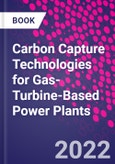Carbon Capture Technologies for Gas-Turbine-Based Power Plants explores current progress in one of the most capable technologies for carbon capture in gas-turbine-based power plants. It identifies the primary benefits and shortcomings of oxy-fuel combustion CO2 capture technology compared to other capture technologies such as pre-combustion and post-combustion capture. This book examines over 20 different oxy-combustion turbine (oxyturbine) power cycles by providing their main operational parameters, thermodynamics and process modelling, energy and exergy analysis and performance evaluation. The conventional natural gas combined cycle (NGCC) power plant with post-combustion capture used as the base-case scenario. The design procedure and operational characteristics of a radial NOx-less oxy-fuel gas turbine combustor are presented with CFD simulation and performance analysis of the heat exchanger network and turbomachinery. Overview of oxygen production and air separation units (ASU) and CO2 compression and purification units (CPU) are also presented and discussed. The most advanced stages of development for the leading oxyturbine power cycles are assessed using techno-economic analysis, sensitivity, risk assessments and levelized cost of energy (LCOE) and analysing technology readiness level (TRL) and development stages. The book concludes with a road map for the development of future gas turbine-based power plants with full carbon capture capabilities using the experiences of the recently demonstrated cycles.
Please Note: This is an On Demand product, delivery may take up to 11 working days after payment has been received.
Table of Contents
1. An Introduction to Gas Turbine Systems
2. Main Technologies in CO2 Capture
3. Oxyturbine Power Cycles and Gas-CCS Technologies
4. Process Modelling and Performance Analysis of The Leading Oxyturbine Cycles
5. Design Characteristics of Oxyfuel Combustion, Heat Exchanger Network and Turbomachinery
6. Oxygen Production and Air Separation Units (ASU)
7. Technoeconomic, Risk Analysis and Technology Readiness Level (TRL) In Oxyturbine Power Cycles
8. Conclusion and Future Works








